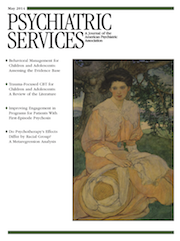Engaging U.S. Veterans With PTSD in Online Therapy
Approximately one-quarter of combat veterans meet diagnostic criteria for posttraumatic stress disorder (PTSD), and many more struggle at subclinical levels. Many service men and women experiencing PTSD symptoms are reluctant to engage in treatment, and nontraditional online health care pathways have been proposed as a possible solution.
We recently completed a year-long project to evaluate the efficacy of several innovative online engagement and assessment methods in a group of 86 male veterans aged 18 to 65, about half of whom had combat-related PTSD. We developed a private, secure, social networking Web site that featured forums and blogs on which users could post openly and interact with other veterans. The site, launched in 2011, also included detailed structured assessments, satisfaction surveys, and other opportunities for users to provide feedback, and it gave access to a library of PTSD educational materials. The veterans were asked to contribute content anonymously on topics of their choosing several times weekly. A psychiatrist served as a facilitator (identified, not anonymous), who logged in daily, checking for any possible abusive language or interactions, monitoring the posts for threats of possible self-harm or dangerousness, and contributing to and facilitating some of the conversations.
Veterans with combat-related PTSD were substantially more difficult to engage than veterans without PTSD. We had greater difficulty recruiting them to the program, and overall they participated much less in the online environment. Veterans with PTSD who were active users of the site were more likely to have already had PTSD treatment before starting the program. We posit that engagement difficulty was at least in part due to the trauma-avoidance features of PTSD. Veterans with more extensive treatment histories may have participated more fully because they were effectively “immunized” by previous treatment to the possible effects of recall of trauma. These findings suggest that the nature of PTSD (trauma avoidance) and the associated cognitive issues (difficulty concentrating and remembering) and related symptoms (substance abuse, depression, and anger) may reduce the likelihood of engagement in, and effectiveness of, online programs, just as these issues do with traditional in-person programs.
Our other engagement-related and retrospective observation is that we did not undertake a sufficiently comprehensive assessment of “e-health literacy” despite asking what we thought were detailed screening questions about computer knowledge and access to ensure the veterans could use the Web site effectively. E-health literacy has been defined as the ability of a person to seek, find, understand, and use health information from electronic sources and then apply that knowledge to the resolution of a particular health problem. To be considered e-health literate, an individual needs to initially possess the skills required for traditional literacy (sufficient reading and writing skills) as well as adequate computer skills. Even though most of the veterans in the program had these skills, a significant proportion did not, which may have hampered their participation. Web sites for veterans should be planned carefully to ensure that the design is appropriate for and acceptable to this group and that site navigation is straightforward.
Despite the barriers noted, we obtained large amounts of written language to analyze with machine learning techniques for the purpose of assessing veterans for PTSD. The main themes discussed on the site were support and sharing, which often involved stories of personal pain and distress. Advice and help were offered, especially about how to navigate health systems to obtain good care. Many veterans compared experiences over time, particularly across different war environments (Vietnam and Korea versus Iraq and Afghanistan). Overall, veterans reported that the online experience was helpful and beneficial, although a few believed that the online conversations triggered their PTSD symptoms and thus their choice to discontinue engaging with the site. These individuals had received minimal prior treatment.
In summary, we found that the nature of PTSD and associated issues, such as trauma avoidance, may make veterans with combat-related PTSD particularly difficult to engage in online programs and that prior treatment experience may be a factor in online intervention effectiveness with this group. Furthermore, we believe that e-health literacy is an important issue to consider when developing online clinical assessment tools and environments and when considering online interventions.



